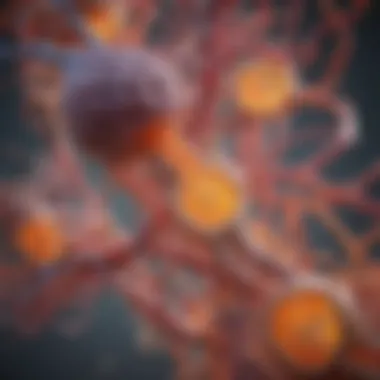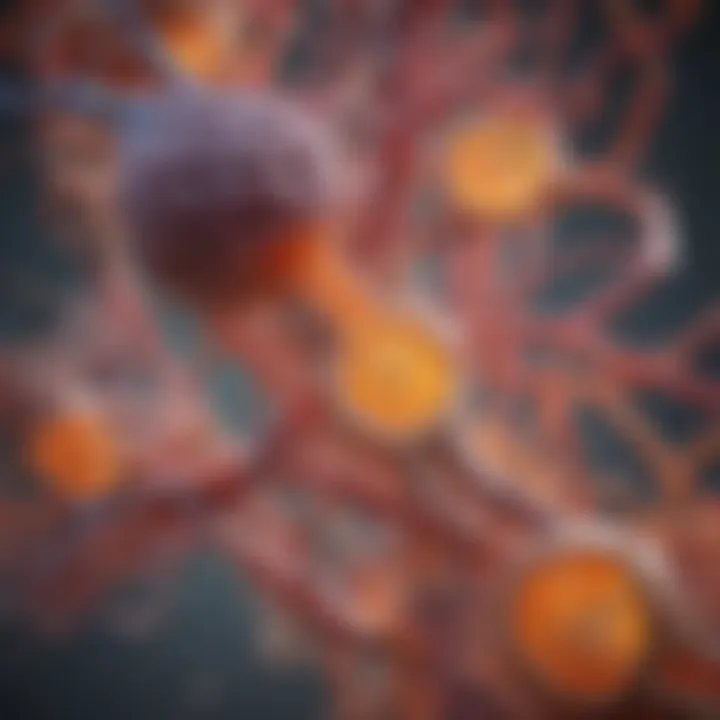Understanding Disaccharidase Deficiency: Causes and Care


Intro
Disaccharidase deficiency is an important area of study in biochemistry that has implications for nutrition and health. It refers to a group of disorders where the body lacks specific enzymes that are crucial for digesting disaccharides. This leads to various gastrointestinal issues and nutrient malabsorption. The significance of understanding this condition extends beyond academics; it directly affects dietary choices and overall health management for those affected.
As awareness grows, the complexities surrounding disaccharidase deficiency are becoming better elucidated. This exploration seeks to highlight key aspects such as the biochemical mechanisms, clinical manifestations, diagnosis, and the dietary implications essential for effective management. Through this narrative, readers will gain insights into recent advances in research and technology that further our understanding of this condition, thus fostering a more informed approach to healthcare management.
Recent Advances
Latest Discoveries
Recent studies have shed light on the genetic and biochemical underpinnings of various disaccharidase deficiencies. It is now understood that mutations in specific genes can lead to a deficiency in enzymes like sucrase-isomaltase, lactase, and maltase-glucoamylase. These deficiencies manifest clinical symptoms like bloating, diarrhea, and abdominal pain upon ingestion of foods containing disaccharides such as sucrose and lactose.
The identification of these mutations opens new avenues for genetic testing. Families affected by these conditions can receive tailored advice based on genetic predisposition, which enhances dietary management and improves quality of life.
Technological Innovations
Advancements in diagnostic techniques play a crucial role in confirming disaccharidase deficiencies. Techniques such as molecular genetic testing are becoming more commonplace, enabling healthcare providers to diagnose conditions with greater accuracy and speed. Additionally, improvements in enzyme replacement therapies are being explored to manage symptoms effectively.
These innovations highlight a commitment to not only understanding genetic factors but also developing practical solutions for individuals affected by this condition.
Methodology
Research Design
The design of research surrounding disaccharidase deficiency often employs a multidisciplinary approach. It integrates biochemical analysis, genetic testing, and clinical evaluations. Randomized control trials and observational studies are frequently conducted to assess the effectiveness of dietary interventions and treatments.
Data Collection Techniques
Data collection for understanding disaccharidase deficiencies may include:
- Patient questionnaires to gather information on symptoms and dietary habits.
- Blood tests to assess enzyme levels and genetic testing results.
- Dietary studies to monitor food intake and gastrointestinal responses.
The combination of qualitative and quantitative data strengthens the understanding of this condition and informs clinical practices.
Understanding the nuances of disaccharidase deficiencies is crucial for effective management and improving patient outcomes.
This comprehensive view of disaccharidase deficiency will serve as a valuable resource not only for medical professionals but also for those interested in the underlying biochemical mechanisms and their impacts on health.
Foreword to Disaccharidase Deficiency
Disaccharidase deficiency represents a critical area of interest in understanding digestive health and nutrition. This section provides the foundational knowledge necessary to appreciate the complexities of this condition. The investigation into disaccharidase deficiencies reveals not only biochemical mechanisms but also clinical implications that affect individuals' lives significantly. An in-depth exploration into this topic can demystify symptoms and promote better diagnosis and management strategies.
Definition and Overview
Disaccharidase deficiency refers to a group of disorders where the body lacks the necessary enzymes to properly digest disaccharides. Disaccharides, are sugar molecules made of two monosaccharides linked together. Common examples include sucrose, lactose, and maltose. Each of these requires an enzyme for digestion. For instance, lactose needs lactase, while sucrose requires sucrase. When these enzymes are deficient, it results in the incomplete breakdown of disaccharides, leading to gastrointestinal symptoms and nutritional complications.
It is not always easy to diagnose disaccharidase deficiency. Affected individuals may experience symptoms such as bloating, diarrhea, and abdominal pain after consuming foods containing disaccharides. These symptoms can vary based on the type and level of enzyme deficiency. Understanding these definitions is crucial for medical professionals and researchers who aim to address these deficiencies effectively.
Historical Context
The historical context of disaccharidase deficiency provides insight into how our understanding of this condition evolved over time. Initially, the link between enzyme deficiencies and gastrointestinal disorders was not well recognized. For most of the 20th century, many individuals suffered silently, unaware of the underlying issues caused by disaccharidase deficiency.
In the 1960s and 1970s, advancements in biochemistry began to unveil the significance of enzymes in digestion. Research identified specific enzymes relevant to disaccharide digestion and detailed how their deficiencies led to clinical manifestations. The discovery of the genetic basis for some forms of disaccharidase deficiency has further shaped how we view these disorders today.
Modern approaches now integrate genetic assessment and dietary management for better health outcomes. Understanding this history is essential as it highlights the progress made and informs current clinical practices. With ongoing research, there is much potential to improve diagnostic capabilities and treatment effectiveness.
"Understanding the historical context of disaccharidase deficiency helps us appreciate the advancements in diagnostic and treatment options available today."
Through rigorous investigation, we can better support those with disaccharidase deficiency and enhance their quality of life.
Understanding Disaccharides
Disaccharides are essential sugars formed by the combination of two monosaccharides. The knowledge of disaccharides is important in the context of disaccharidase deficiency, as this condition revolves around the body's inability to effectively digest these sugars. Understanding disaccharides provides insight into the causes and symptoms of disaccharidase deficiency, which can help in developing targeted treatments and dietary guidelines for affected individuals.
Types of Disaccharides
There are three primary types of disaccharides: sucrose, lactose, and maltose.
- Sucrose: Composed of glucose and fructose, sucrose is commonly known as table sugar. It is found naturally in many plants, particularly in sugar cane and sugar beets.
- Lactose: This disaccharide consists of glucose and galactose. Lactose is the sugar primarily found in milk and dairy products. Many individuals experience difficulty digesting lactose, leading to lactose intolerance.
- Maltose: Formed from two glucose units, maltose is produced during the digestion of starch. It is present in malted foods and beverages, including beer.


Each of these disaccharides requires specific disaccharidases for proper digestion, highlighting the importance of understanding the role each chemcial plays in human health.
Biochemical Role in Digestion
Disaccharides play a crucial role in human nutrition and metabolism. Once ingested, disaccharides are broken down into their monosaccharide components by enzymes known as disaccharidases.
- Enzyme Function: Disaccharidases are produced in the brush border of the small intestine. They catalyze the hydrolysis of disaccharides into monosaccharides, allowing for efficient absorption.
- Nutrient Absorption: The monosaccharides generated from disaccharides, such as glucose and galactose, are easily absorbed into the bloodstream and subsequently utilized by the body for energy.
The inability to digest disaccharides due to enzyme deficiencies leads to gastrointestinal symptoms and nutrient malabsorption. Understanding these biochemical processes is key to addressing the challenges associated with disaccharidase deficiency.
Proper digestion of disaccharides is critical for maintaining energy levels and overall health. Without adequate enzyme function, individuals may experience discomfort and nutritional deficiencies.
In summary, disaccharides are integral to dietary intake and must be understood within the scope of disaccharidase deficiency. By recognizing their types and roles in digestion, we equip ourselves with knowledge that facilitates better management and treatment of related conditions.
The Role of Disaccharidases
Disaccharidases play a crucial role in the digestive process, specifically in the breakdown of disaccharides into simpler sugars. This process is essential for nutrient absorption. When a disaccharidase is deficient, it can lead to various digestive issues, emphasizing the importance of these enzymes in overall health. The understanding of their functions and mechanisms is vital for students, researchers, and professionals in the field, as it forms the foundation for diagnosing and managing disaccharidase deficiencies.
Key Disaccharidases and Their Functions
The most notable disaccharidases include sucrase, isomaltase, maltase, and lactase. Each of these enzymes has specific substrates and functions:
- Lactase: This enzyme breaks down lactose, found in milk and dairy products, into glucose and galactose. Lack of lactase can cause lactose intolerance, a common condition globally.
- Maltase: Maltase is responsible for hydrolyzing maltose into two molecules of glucose. It's important for the digestion of starches, particularly those from grains.
- Sucrase-Isomaltase: This enzyme complex is crucial for the digestion of sucrose and isomaltose. Deficiencies in both can lead to an inability to properly digest sugar-rich foods.
- Lactase-Phlorizin Hydrolase: Apart from breaking down lactose, this enzyme also helps in metabolizing phlorizin, a plant-derived sugar.
These enzymes facilitate the absorption of essential nutrients, thus preventing malnutrition and related health problems. The consequences of deficiencies can lead to various gastrointestinal symptoms like bloating, diarrhea, and abdominal pain.
Mechanism of Action
The action of disaccharidases occurs in the small intestine, where they are secreted by the intestinal lining. They bind to their specific substrates, disaccharides, and catalyze their hydrolysis into monosaccharides, which are then readily absorbed into the bloodstream. The specific steps include:
- Enzyme-Substrate Binding: The disaccharide binds to the active site of the disaccharidase.
- Hydrolysis Reaction: Water molecules assist in breaking the glycosidic bond between the sugar units.
- Release of Monosaccharides: The product of this reaction is glucose, galactose, or fructose, depending on the disaccharide involved.
For individuals with disaccharidase deficiency, this molecular process is disrupted, leading to the accumulation of undigested sugars in the intestines, which can cause osmotic diarrhea and intestinal discomfort.
It's important to note that understanding disaccharidases is essential not only for diagnosing deficiencies but also for developing effective management strategies.
Mechanisms of Disaccharidase Deficiency
Understanding the mechanisms of disaccharidase deficiency is vital for comprehending its broader impacts on health and nutrition. Disaccharidases are enzymes responsible for breaking down disaccharides into monosaccharides. Deficiency in these enzymes leads to inadequate digestion, causing a range of gastrointestinal symptoms. This section will explore the genetic and acquired causes of disaccharidase deficiency, which are critical for diagnosis and treatment strategies.
Genetic Causes
Genetic factors play a significant role in disaccharidase deficiency. Several genes are linked to the production of disaccharidases, such as lactase, sucrase-isomaltase, and maltase-glucoamylase. Mutations in the genes responsible for these enzymes can lead to their underproduction or complete absence. For example, lactase deficiency occurs often due to lactase-phlorizin hydrolase gene polymorphisms. Over time, this deficiency can result in lactose intolerance, predominantly among specific ethnic groups.
Here are some key points regarding genetic causes:
- Hereditary Patterns: Some forms of disaccharidase deficiency show autosomal recessive inheritance, while others can be inherited in complex ways.
- Variability: The severity of deficiency may vary widely among individuals due to different genetic backgrounds.
- Screening: Family history can help identify at-risk individuals through genetic counseling.
Understanding these genetic components is essential for formulating personalized treatment approaches and dietary recommendations.
Acquired Causes
Acquired causes also contribute significantly to disaccharidase deficiency. Unlike genetic factors, these causes can develop over the lifespan due to various environmental and health-related influences.
Key acquired causes include:
- Infections: Gastrointestinal infections, such as viral gastroenteritis, can temporarily impair disaccharidase activity.
- Celiac Disease: This autoimmune disorder damages the small intestine and can lead to reduced enzyme levels, including those necessary for disaccharide digestion.
- Intestinal Inflammation: Conditions like Crohn's disease and ulcerative colitis can damage the intestinal lining, impacting enzyme production.
- Medications: Certain drugs can interfere with intestinal health and enzyme activity, contributing to disaccharidase deficiency.
Understanding the distinction between genetic and acquired causes can aid in better management and targeted healthcare responses for those affected by disaccharidase deficiencies.
"Identifying whether the deficiency is genetic or acquired is crucial for treatment and dietary management strategies."
Clinical Manifestations
Understanding clinical manifestations of disaccharidase deficiency is essential in appreciating its impact on individuals' health. This section provides an overview of the common symptoms associated with the condition, their effects on daily life, and the critical process of differentiating these symptoms from other medical issues. By highlighting these aspects, we emphasize the need for nuanced approaches to diagnosis and management.
Common Symptoms
Disaccharidase deficiency presents a range of symptoms that can vary significantly based on the specific enzyme affected. Some of the most common symptoms include:
- Abdominal Pain: Patients may experience cramping or discomfort in the stomach area, often exacerbated after consuming foods containing disaccharides such as sucrose or lactose.
- Bloating: Many individuals report a sensation of fullness or swelling in the abdominal region, which can be distressing and uncomfortable.
- Diarrhea: This symptom arises due to malabsorption of disaccharides, leading to osmotic diarrhea, where unabsorbed sugars attract water into the intestines.
- Flatulence: The fermentation of undigested disaccharides by gut bacteria can result in increased gas production, causing discomfort and social embarrassment.


Aside from gastrointestinal symptoms, patients may also face fatigue and general malaise, which can stem from nutrient malabsorption leading to deficiencies.
Impact on Quality of Life
The impact of disaccharidase deficiency extends beyond physical symptoms. Many individuals find that their condition affects their quality of life in various ways.
- Social Limitations: The fear of experiencing symptoms in public may lead to avoidance of social events, dining out, or participating in shared meals, causing feelings of isolation.
- Nutritional Deficiencies: Difficulties in digesting certain carbohydrates can limit one's diet, reducing the intake of essential nutrients, and potentially leading to other health issues over time.
- Mental Health Concerns: Chronic discomfort and dietary restrictions may contribute to anxiety and depression. Coping with a condition that can be misunderstood by others adds to the emotional burden.
It is essential to acknowledge these aspects in providing comprehensive care to affected individuals.
Differentiation from Other Conditions
Disaccharidase deficiency can mimic or overlap with other gastrointestinal disorders, complicating diagnosis. Conditions that need to be differentiated from disaccharidase deficiency include:
- Irritable Bowel Syndrome (IBS): Both conditions can present with abdominal pain and changes in bowel habits, often necessitating careful evaluation to distinguish between them.
- Celiac Disease: This autoimmune condition also leads to malabsorption and gastrointestinal symptoms, requiring gluten-free dietary management. Testing for specific antibodies can aid in differential diagnosis.
- Lactose Intolerance: Symptoms can resemble those of lactase deficiency, hence lactose intolerance testing might be important for accurate diagnosis.
It is crucial for healthcare providers to conduct thorough evaluations, including clinical history and appropriate tests, to ensure that disaccharidase deficiency is identified correctly and managed effectively.
In summary, clinical manifestations of disaccharidase deficiency are diverse and can significantly affect life quality. Recognizing symptoms, understanding their implications, and differentiating the condition from similar disorders are vital steps in improving diagnosis and treatment.
Diagnosis of Disaccharidase Deficiency
Diagnosis of disaccharidase deficiency is a critical aspect of understanding this group of disorders. Proper diagnosis allows for targeted management strategies aimed at relieving symptoms and improving patient quality of life. Lack of timely diagnosis can lead to complications stemming from untreated malabsorption and persistent gastrointestinal discomfort. Understanding how to accurately diagnose this condition is essential for healthcare providers.
Clinical Assessment
Clinical assessment plays an important role in diagnosing disaccharidase deficiency. When a patient presents with gastrointestinal symptoms such as bloating, diarrhea, or abdominal pain after consuming certain foods, careful evaluation is necessary. During the assessment, the healthcare provider must take a detailed history of the patient’s dietary habits, symptoms, and any previous medical conditions. Factors such as age and family history may also contribute valuable context. Observing the patient for signs of malnutrition or dehydration is significant, as these may indicate a deficiency.
Additionally, healthcare professionals need to differentiate between disaccharidase deficiency and other conditions that can cause similar symptoms, such as lactose intolerance or other forms of carbohydrate malabsorption.
Practitioners may utilize a symptom diary as a tool for patients to log food intake and subsequent reactions. This documentation can help in identifying potential disaccharide-related intolerances.
Laboratory Tests
Laboratory tests provide further validation for the diagnosis of disaccharidase deficiency. Specific tests aimed at measuring enzyme activity are commonly employed. For instance, the measurement of enzyme levels in intestinal biopsies can confirm the deficiency of disaccharidases like sucrase-isomaltase or lactase.
Another test involves the hydrogen breath test, which is non-invasive and measures the amount of hydrogen produced after consuming a disaccharide solution. Elevated hydrogen levels suggest malabsorption. Such tests can guide clinicians in making an informed diagnosis.
Maintaining clear records of laboratory findings is necessary. These results can assist in tracking the patient’s progress over time and evaluating the effectiveness of dietary management strategies.
Genetic Testing
Genetic testing offers additional insights into disaccharidase deficiency. By identifying specific genetic mutations associated with enzyme deficiencies, healthcare professionals can provide a more precise diagnosis. For instance, certain mutations in the SI gene have been linked to sucrase-isomaltase deficiency.
Genetic analysis may not be part of the initial diagnosis but can be invaluable in cases where symptoms are severe, or when the enzyme deficiency is suspected to be hereditary. Early identification may lead to customized treatment plans for patients and inform family members of potential genetic conditions.
Taking a thorough approach to genetic testing, alongside clinical and laboratory examinations, enhances the accuracy of diagnosis.
Accurate diagnosis is vital for effective management and treatment of disaccharidase deficiency.
Management and Treatment Strategies
Managing disaccharidase deficiency requires a comprehensive approach that balances dietary modifications, supplementation, and innovative treatments. The importance of management and treatment strategies lies primarily in improving the quality of life for individuals affected by this condition. Effective management not only alleviates symptoms but also addresses the underlying biochemical issues that arise from enzyme deficiencies.
Dietary Management
Dietary management is central to coping with disaccharidase deficiency. Individuals must avoid foods high in disaccharides related to their specific enzyme deficiencies, such as lactose in the case of lactase deficiency or sucrose for sucrase deficiency. By restricting these sugars, patients can mitigate gastrointestinal distress, which can include symptoms like bloating, diarrhea, and abdominal pain.
- Identifying trigger foods: It's vital for individuals to learn which foods contain disaccharides they cannot digest. This means careful reading of food labels and often consulting with a dietitian to formulate a safe eating plan.
- Incorporating alternatives: Substituting disaccharides with monosaccharides or simple carbohydrates can be beneficial. For example, lactose-free dairy products can serve as substitutes for those with lactase deficiency.
Ultimately, the goal of dietary management is to maintain nutritional balance while avoiding discomfort. An individualized approach that caters to one's specific intolerances makes for a resilient management strategy.
Supplementation Options
For those with disaccharidase deficiency, supplementation presents a promising avenue to enhance enzyme levels in the gut. Using enzyme supplements can provide a means to digest troublesome disaccharides. This can significantly improve the quality of life and ease dietary restrictions.
- Exogenous enzyme supplements: Products containing lactase or other disaccharidases can help some individuals digest specific sugars they normally cannot. For example, taking lactase tablets before consuming dairy can allow some patients to enjoy these foods without severe digestive issues.
- Benefits and considerations: However, patients should consult healthcare providers before starting supplementation. Not all individuals may respond positively, and there might be varying effectiveness depending on the severity of the deficiency.
Innovative Treatments


Research continues to make strides toward innovative treatments for disaccharidase deficiency. While current management strategies focus primarily on dietary changes and supplements, future developments may provide more robust solutions.
- Gene therapy: Emerging approaches like gene therapy aim to correct genetic causes of disaccharidase deficiencies. Though still in experimental phases, these therapies hold the potential to change the landscape of treatment fundamentally.
- Novel enzymatic therapies: There are ongoing studies exploring synthetic enzymes that can replace deficient ones in the gut. These treatments seek to enhance the digestion of disaccharides even in the absence of the natural enzymes.
Research into these innovative treatments is critical. While dietary management and supplementation are effective, they require ongoing commitment and can be restrictive. Each of these strategies contributes to the overall management of disaccharidase deficiency and underscores the importance of versatile treatment plans.
"Management is not just about treatment; it's about empowering patients to lead fuller lives despite their conditions."
Prognosis and Long-Term Considerations
The prognosis for individuals with disaccharidase deficiency is variable and depends on several key factors. Understanding these factors is essential for managing the condition effectively. Long-term considerations also greatly impact overall health and quality of life. This section highlights some significant elements related to long-term health implications and psychosocial aspects of managing disaccharidase deficiency.
Long-Term Health Implications
Disaccharidase deficiencies often lead to malabsorption of specific nutrients, which can have profound impacts on health. For instance, individuals with sucrose-isomaltase deficiency struggle to digest sucrose, leading to gastrointestinal symptoms and nutrient deficiencies. These may contribute to poor growth in children and malnutrition in adults.
Some common long-term health implications include:
- Nutritional Deficiencies: Prolonged malabsorption can result in deficiencies of essential vitamins and minerals, impacting overall health.
- Gastrointestinal Disorders: Chronic digestive issues may occur, including frequent diarrhea, bloating, and abdominal pain.
- Growth Retardation: In children, inadequate nutrient absorption can lead to stunted growth and developmental delays.
- Increased Risk of Other Conditions: There is a potential for associated conditions, such as lactose intolerance or other gastrointestinal diseases, to develop due to ongoing digestive issues.
Importantly, early diagnosis and appropriate dietary interventions can significantly mitigate these risks, allowing many individuals to lead healthy lives despite their condition.
Psychosocial Aspects
The psychological and social impacts of living with disaccharidase deficiency should not be overlooked. Navigating dietary restrictions can lead to a range of emotional and social challenges.
Considerations in this area include:
- Social Isolation: Individuals may feel isolated when dining out or attending social events where food is a central aspect. This can lead to anxiety and a feeling of being different.
- Mental Health Issues: Anxiety and depression may occur due to frustration with managing the condition or the stress of dietary limitations.
- Support Systems: Accessible support groups or resources can help individuals cope with the emotional aspects of this condition. Connecting with others who share similar experiences can be empowering.
A supportive environment is crucial for both emotional well-being and adherence to dietary management in patients with disaccharidase deficiency.
In summary, understanding the long-term health implications is critical for effective management of disaccharidase deficiency. Alongside, addressing the psychosocial aspects offers a holistic approach to care, improving both health outcomes and quality of life.
Research Frontiers
Research in disaccharidase deficiency is gaining significance as more is known about its impact on health and nutrition. Understanding the mechanisms behind these enzyme deficiencies enables better diagnosis and management. The exploration of current and future research directions provides insight not only into the condition itself but also into broader implications for gastrointestinal health and dietary choices.
Investigating disaccharidase deficiencies is vital for several reasons. First, as awareness of these disorders grows, so does the necessity for effective treatment strategies. Patients often remain undiagnosed or misdiagnosed due to overlapping symptoms with other digestive conditions. Current research trends aim to bridge this gap by improving diagnostic criteria and methodologies.
Current Research Trends
Current research trends focus primarily on examining the genetic basis of disaccharidase deficiencies. Advances in genomic studies have shed light on various genetic mutations that can lead to enzyme deficits. For instance, studies uncover the role of the lactase gene (LCT) in lactose intolerance, a commonly recognized disaccharidase deficiency. The exploration of other disaccharidases, such as sucrase-isomaltase, is also critical. Researchers are utilizing new techniques in molecular biology to identify variants that may affect enzyme activity.
Additionally, the connection between disaccharidase deficiencies and gut microbiota is being studied. The gut microbiome plays a significant role in digestion and metabolic health. Research is ongoing to see how enzyme deficiencies influence microbial composition and vice versa. This interplay has implications for personalized dietary recommendations, guiding further studies that scrutinize the impact of specific diets on individuals with these deficiencies.
Data from clinical trials also contribute to the current research trends. More studies are examining the effectiveness of enzyme supplementation in managing symptoms. For example, lactase supplements are commonly used for lactose intolerance, but there is ongoing research into how effectively they relieve symptoms in diverse populations.
Future Directions in Research
Looking ahead, future directions in research on disaccharidase deficiency hinge on several key elements. One significant area is the development of more refined diagnostic tools. Traditional tests are often invasive and may not accurately reflect mild deficiencies. Future research aims to create non-invasive tests that can assess enzyme activity with precision, possibly incorporating advanced imaging techniques or biomarker identification.
Another focus is on therapeutic strategies. Innovative treatment approaches, such as gene therapy, may become feasible. Researchers are exploring how to correct genetic mutations responsible for enzyme deficiencies, changing the landscape of treatment possibilities. It suggests a shift towards more long-term and possibly curative options.
Research into diet is also necessary as the understanding of disaccharidase deficiency evolves. Personalized nutrition based on specific enzyme deficiencies could lead to better health outcomes. Understanding how to balance nutritional intake while circumventing problematic disaccharides is vital. Continued investigation into the relationship between disaccharides, fiber, and overall gut health is expected to yield new insights.
"Exploration of disaccharidase deficiency can help reshape dietary norms and improve the quality of life for those affected."
Overall, the frontiers of research in disaccharidase deficiency are promising. As studies uncover more about the genetic, microbial, and nutritional aspects of this condition, the potential for improved management and treatment strategies grows. This knowledge not only benefits those diagnosed but also enriches the understanding of carbohydrate metabolism and gastrointestinal health for the broader population.
The End
The conclusion serves as a critical reflection on disaccharidase deficiency, summarizing the complexities discussed throughout this article. Understanding this condition is not only essential for healthcare professionals but also for anyone affected by it. The main thoughts outlined here reinforce the importance of early diagnosis and effective management strategies that directly impact patient outcomes.
Summary of Key Insights
Disaccharidase deficiency includes a variety of disorders related to specific enzyme deficiencies. These deficiencies lead to a range of digestive issues, primarily affecting an individual’s ability to process certain sugars. Here are some key insights from the article:
- Biochemical Mechanisms: The role of disaccharidases in digestion is integral, with their absence directly resulting in symptoms of malabsorption.
- Clinical Manifestations: Common symptoms, such as abdominal pain and bloating, affect daily life, necessitating a thorough understanding of the condition.
- Diagnosis and Management: Accurate diagnosis through clinical assessments and laboratory tests is crucial. Various management strategies exist, including dietary changes and supplementation options.
"Effective management of disaccharidase deficiency can vastly improve quality of life for those affected."
This summary encapsulates the essence of disaccharidase deficiency, highlighting the necessity for ongoing research and education to enhance understanding and treatment.
Final Thoughts
Reflecting on disaccharidase deficiency encourages a broader view of nutrition and health. Individuals and healthcare providers alike should prioritize awareness and understanding of enzyme-related digestion issues. This condition can lead to significant health impacts but is manageable with appropriate interventions. Future research is expected to illuminate genetic factors further and explore new therapies. The goal is to evolve our understanding and improve the lives of those living with disaccharidase deficiency. Also, as we gain more insights into these disorders, it is crucial to continue advocating for better diagnostic and treatment options, ensuring that people can lead healthier lives without the limitations imposed by their condition.















